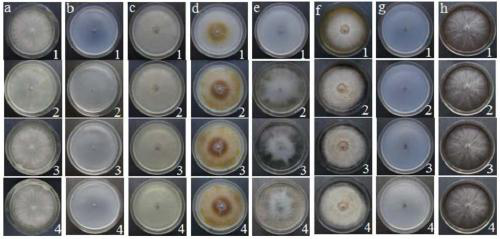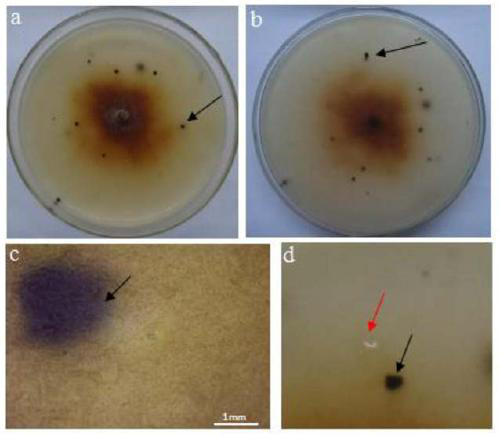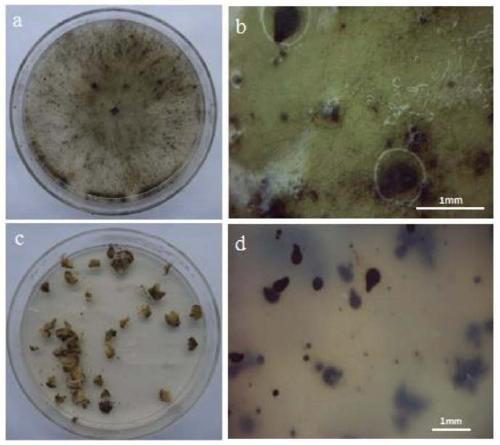Mulberry endophytic antagonistic bacteria new species-podosporia sp. and application thereof
A technology of sporophytes and endophytic fungi, applied in the fields of application, biocides, and microorganisms, can solve the problems of no high-yield, high-quality, disease-resistant fruit mulberry varieties, inability to prevent and control sclerotinia sclerotinia, and large labor input.
- Summary
- Abstract
- Description
- Claims
- Application Information
AI Technical Summary
Problems solved by technology
Method used
Image
Examples
Embodiment 1
[0034] Example 1: Isolation, purification and screening of endophytic antagonistic bacteria in mulberry trees
[0035] 1. Isolation and purification of mulberry endophytes
[0036] 1.1. Isolation of endophytes:
[0037] Collection and storage of samples: Collect mulberry stems from mulberry gardens, rinse them with tap water, dry them, store numbers at 4°C, and isolate endophytes in time.
[0038] Isolation of endophytes: cut the stems of mulberry trees into small sections (3.0-5.0 cm in length), soak them in 75.0% alcohol completely, take them out, ignite the alcohol on the surface of the stems on an alcohol lamp, and wait for the alcohol to burn out. Roll the mulberry branches sterilized on this surface on the blank medium, so that each surface of the mulberry branches is in contact with the medium, and use it as a blank control to verify whether the surface disinfection is thorough. Then it was placed in a sterile petri dish and cut open in three layers with a sterile sca...
Embodiment 2
[0044] Embodiment 2: the influence of temperature on the growth of antagonistic fungus 7GJ-4
[0045] Inoculate the pathogenic bacteria cake with a diameter of 5 mm on the center of the PDA plate, and culture it at 5°C, 10°C, 15°C, 20°C, 25°C, 30°C, 35°C, and 40°C, and measure the colony diameter with the cross method every day. Repeat 3 times for each group.
Embodiment 3
[0046] Embodiment 3: thermal stability, lethal effect of 7GJ-4 fermented liquid
[0047] 1. Detection of thermal stability of active fermentation liquid of antagonistic fungus 7GJ-4 strain
[0048] The aseptic fermentation filtrate of the antagonistic fungus 7GJ-4 was placed at 40°C, 60°C, 80°C, and 100°C for 30 minutes, and after cooling to room temperature, the hyphae growth rate method was used (the sterile fermentation filtrate was mixed at a volume of 1:4 Mix with sterilized PDA medium cooled to 40-50°C to prepare a detection plate, and mix with sterilized water and PDA medium at a volume ratio of 1:4 to prepare a control plate, and then separate the pathogenic bacteria cakes with a diameter of 5mm Inoculate in the center of the test plate and the control plate, culture at 22°C for several days, measure the colony diameter by the cross method, and repeat 3 times in each group. Calculate the antibacterial rate by comparing the colony diameter of the test plate with the col...
PUM
 Login to View More
Login to View More Abstract
Description
Claims
Application Information
 Login to View More
Login to View More - R&D
- Intellectual Property
- Life Sciences
- Materials
- Tech Scout
- Unparalleled Data Quality
- Higher Quality Content
- 60% Fewer Hallucinations
Browse by: Latest US Patents, China's latest patents, Technical Efficacy Thesaurus, Application Domain, Technology Topic, Popular Technical Reports.
© 2025 PatSnap. All rights reserved.Legal|Privacy policy|Modern Slavery Act Transparency Statement|Sitemap|About US| Contact US: help@patsnap.com



